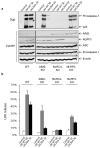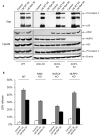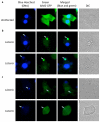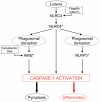Involvement of the AIM2, NLRC4, and NLRP3 inflammasomes in caspase-1 activation by Listeria monocytogenes
- PMID: 20490635
- PMCID: PMC3321545
- DOI: 10.1007/s10875-010-9425-2
Involvement of the AIM2, NLRC4, and NLRP3 inflammasomes in caspase-1 activation by Listeria monocytogenes
Abstract
Infection with Listeria monocytogenes can cause meningitis and septicemia in newborn, elderly, or immunocompromised individuals. Pregnant women are particularly susceptible to Listeria, leading to a potentially fatal infection. Cytosolic Listeria activates the proinflammatory caspase-1 and induces the processing and secretion of interleukins IL-1beta and IL-18 as well as caspase-1-dependent pyroptosis. This study elucidates the role of various inflammasome components of host macrophages in the proinflammatory response to infection with Listeria. Here, we have used macrophages from AIM2-, NLRC4-, NLRP3-, and ASC-deficient mice to demonstrate that AIM2, NLRC4, and NLRP3 inflammasomes as well as the adaptor protein ASC all contribute to activation of caspase-1 in Listeria-infected macrophages. We show that Listeria DNA, which escapes into the cytosol of infected macrophages, triggers AIM2 oligomerization, caspase-1 activation, and pyroptosis. Interestingly, we found that flagellin-deficient Listeria, like Francisella tularensis, is recognized primarily by the AIM2 inflammasome, as no caspase-1 activation or cell death was observed in AIM2-deficient macrophages infected with this Listeria mutant. We further show that prior priming of NLRC4-deficient macrophages with LPS is sufficient for Listeria-induced caspase-1 activation in these macrophages, suggesting that TLR4 signaling is important for activation of the AIM2 and NLRP3 inflammasomes by Listeria in the absence of NLRC4. Taken together, our results indicate that Listeria infection is sensed by multiple inflammasomes that collectively orchestrate a robust caspase-1 activation and proinflammatory response.
Figures






Similar articles
-
Involvement of absent in melanoma 2 in inflammasome activation in macrophages infected with Listeria monocytogenes.J Immunol. 2010 Jul 15;185(2):1186-95. doi: 10.4049/jimmunol.1001058. Epub 2010 Jun 21. J Immunol. 2010. PMID: 20566831
-
Critical role of ASC inflammasomes and bacterial type IV secretion system in caspase-1 activation and host innate resistance to Brucella abortus infection.J Immunol. 2013 Apr 1;190(7):3629-38. doi: 10.4049/jimmunol.1202817. Epub 2013 Mar 4. J Immunol. 2013. PMID: 23460746
-
Multiple Nod-like receptors activate caspase 1 during Listeria monocytogenes infection.J Immunol. 2008 Jun 1;180(11):7558-64. doi: 10.4049/jimmunol.180.11.7558. J Immunol. 2008. PMID: 18490757 Free PMC article.
-
Caspase-1-induced pyroptotic cell death.Immunol Rev. 2011 Sep;243(1):206-14. doi: 10.1111/j.1600-065X.2011.01044.x. Immunol Rev. 2011. PMID: 21884178 Free PMC article. Review.
-
The inflammasome: a caspase-1-activation platform that regulates immune responses and disease pathogenesis.Nat Immunol. 2009 Mar;10(3):241-7. doi: 10.1038/ni.1703. Nat Immunol. 2009. PMID: 19221555 Free PMC article. Review.
Cited by
-
Human NLRP3 inflammasome activation leads to formation of condensate at the microtubule organizing center.bioRxiv [Preprint]. 2024 Sep 15:2024.09.12.612739. doi: 10.1101/2024.09.12.612739. bioRxiv. 2024. PMID: 39314395 Free PMC article. Preprint.
-
Listeria monocytogenes cancer vaccines: bridging innate and adaptive immunity.Curr Clin Microbiol Rep. 2019 Dec;6(4):213-224. doi: 10.1007/s40588-019-00133-4. Epub 2019 Nov 20. Curr Clin Microbiol Rep. 2019. PMID: 33072493 Free PMC article.
-
Protective and detrimental roles of inflammasomes in disease.Semin Immunopathol. 2015 Jul;37(4):313-22. doi: 10.1007/s00281-015-0485-5. Epub 2015 Apr 21. Semin Immunopathol. 2015. PMID: 25895577 Review.
-
Type I interferon signaling regulates activation of the absent in melanoma 2 inflammasome during Streptococcus pneumoniae infection.Infect Immun. 2014 Jun;82(6):2310-7. doi: 10.1128/IAI.01572-14. Epub 2014 Mar 18. Infect Immun. 2014. PMID: 24643540 Free PMC article.
-
NSD1 mitigates caspase-1 activation by listeriolysin O in macrophages.PLoS One. 2013 Sep 18;8(9):e75911. doi: 10.1371/journal.pone.0075911. eCollection 2013. PLoS One. 2013. PMID: 24058709 Free PMC article.
References
Publication types
MeSH terms
Substances
Grants and funding
LinkOut - more resources
Full Text Sources
Medical
Miscellaneous

